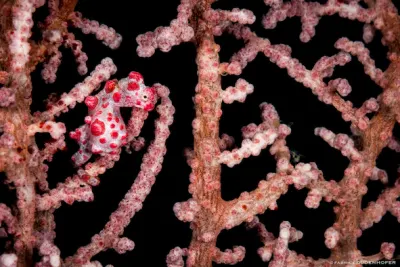As originally reported by The Guardian, there’s big news in the tiny world of macro! A minuscule candy cane-striped pygmy seahorse was recently discovered off New Zealand’s northern coast, and for what is believed to be the first time in history, a local indigenous group has formally named it.
This pint-sized creature, just six centimetres in length, is closely related to the seahorse. Found inhabiting New Zealand’s warm northern waters amid rocky reefs, it is the first pygmy pipehorse species discovered in the country.
The Ngātiwai tribe worked with two biodiversity scientists - Dr Thomas Trnski from Tāmaki Paenga Hira Auckland Museum, and Graham Short of the California Academy of Scientists, to name the new pipehorse. Ultimately, they settled on Cylix tupareomanaia.
Cylix is a new genus name, part of the pipehorse family that are closely related to seahorse. The name itself is derived from the Greek and Latin word for a cup or chalice, referring to the cup-like crest on top of the new species’ head.
The second part of its name, tupareomanaia, comes from two Māori words. “Tupuna” means ancestor or forefather, and “Manaia”, the name of a mythological creature found in Māori legends and folklore. This animal, similar to a seahorse, has the head of a bird, the tail of a fish, and the body of a man. The Manaia is a common motif in Māori carving and jewellery, often worn as a talisman. It is considered the messenger between the earthly world of mortals and the domain of the spirits, a symbol used to guard against evil.
The common name for Cylix tupareomanaia is the Manaia pygmy pipehorse - a further nod to the culture of New Zealand’s first people. The Ngātiwai are pleased to have gifted the new species its name, with tribal kaumātua (Elder) Hori Parata stating, “The naming of this taonga (treasure) is significant to the Ngātiwai, as we know there are stories from our tupuna about this species, but the original name has been lost as a result of the negative impacts of colonisation.”
For Dr Trnski from the Auckland Museum, it was a privilege to incorporate mātauranga (Māori knowledge) into the naming process. He was quoted as saying, “As far as we know, this is the first animal in the world to have the naming authority include a tribal name. It is overdue recognition of traditional knowledge that can contribute to the discovery of new species.”
Cylix tupareomanaia was observed by scuba divers at the Poor Knights Islands Marine Reserve back in 2011 when it was believed to be the rare seahorse species Hippocampus jugumus - the collared seahorse. But when a photo was posted on Facebook in 2017, Short recognised it as potentially new, and Trnski joined him in an effort to confirm it as a new species. The authors of this new name, Short, Trnski and the Ngātiwai people, will be permanently linked to the species, as required under the International Code of Zoological Nomenclature – the scientific rulebook for naming new species.




